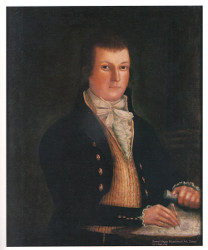Harding Williams (1758-1813)
 Click on image to enlarge or for higher resolution |
Title/Occupation | Captain |
|---|---|---|
| Address | 14 The Strand | |
| Artist | Abraham Delanoy | |
| Date painted | c1785 | |
| Credit | Biggs Museum of American Art, Dover, Delaware | |
| Married | Rebecca Dickinson (1788) | |
| Parents | ||
| Children | ||
| Link | ||
From the paintings and sculpture catalog of the Sewell Biggs Collection of American Art ABRAHAM DELANOY studied painting in London with Benjamin West around 1766. The following year he established his practice as a portrait painter in his birthplace, New York City, but traveled to Charleston, South Carolina, and the West Indies in search of commissions. By 1771 he also operated a general store stocked with wines, rum, molasses, raisins, figs, almonds, chocolate, coffee, sugar, pepper, salt, paper, ink, sealing wax, needles, thread and pins; in addition Delanoy offered: "Most kinds of Painting done as usual, at reasonable prices."! Delanoy next moved to New Haven, Connecticut, where he maintained a portrait studio from 1784 to 1787, and it may have been during this period that he painted the portrait of Captain Williams. But commissions for portraits remained less than plentiful, and the artist supplemented his income by painting shop signs. In the December 18, 1785, Connecticut Journal he advertised: "Likenesses, painted on canvas; Carriages painted, ornamented, gilt and varnished; Signs of all kinds; plain, house and ship Painting & Glazing carried on, by Abraham Delanoy, Painter in oil colours . .. . Putty to be had at all times, and Paints mix'd at a short notice." William Dunlap, early historian of American art, knew Delanoy in the late 1780s and reported that he was poor and consumptive. By 1790 the artist had removed to Westchester County, New York, where he lived for the rest of his life. Harding Williams (1758- 1813) initially sailed schooners from port to port along the coast of the newly established United States. By 1787 he began taking ships on transatlantic voyages that carried him to Lisbon, Dublin, Bordeaux, and Glasgow. In 1788 he married Rebecca Dickinson, and they lived in Philadelphia for a decade before moving to New Castle, Delaware. From their new home at 14 The Strand, which also served as a tavern and an inn, Captain Williams became active in the politics of the busy little port. He died in New Castle and is buried in the cemetery that surrounds Immanuel Episcopal Church on The Strand. In the painting, Williams's handsome coat and fine vest signal his success and prosperity; he holds a set of dividers with which he measures distances on the map, indicative of his profession as sea captain.2 The attribution to Delanoy is based on its stylistic similarities to other portraits that are known to have been painted by the artist, particularly that of John Sherman, Jr.3 A linear definition of form and a soft tonal modeling within it are typical of Delanoy's style in the Sherman portrait, the several Beekman portraits, and the Williams portrait. WC  Immanuel churchyard | ||
Jim Meek
nc-chap.org 2014, 2015
nc-chap.org 2014, 2015